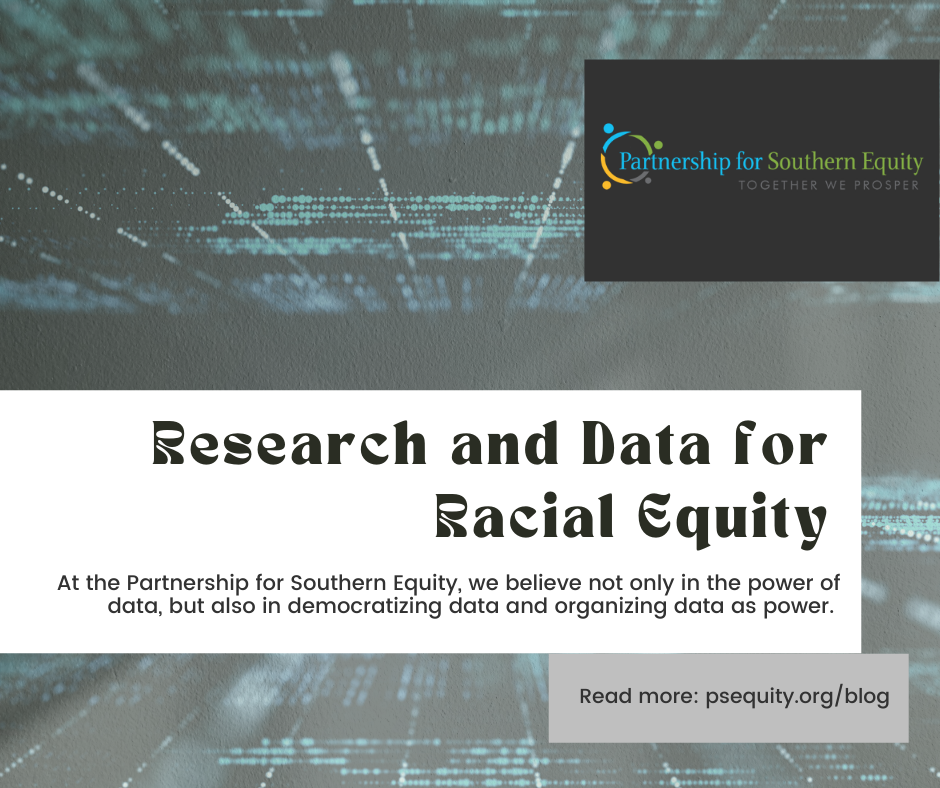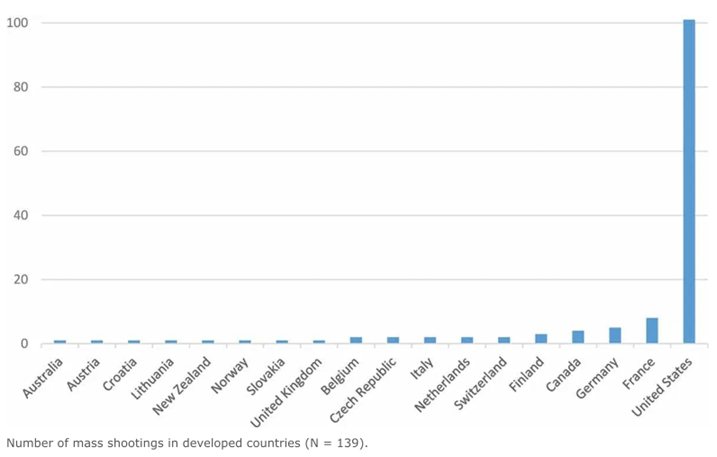The Collective Trauma of Mass Shootings
Caroline Redd, Data, Research, Innovation, and Policy (DRIP)
Robyn Bussey and Tarccara Hodge, Just Health
Allyson Kemp, DRIP Research Assistant

June was Gun Violence Prevention Month. In light of recent mass shootings, we felt it was necessary to address this public health crisis. The way we use data to talk about social issues has a significant impact on the way we live in our communities. That is why at the Partnership for Southern Equity, we believe in democratizing and humanizing data to make knowledge more accessible to everyone involved in the fight for racial equity.
Overview
The frequent occurrence of gun violence, particularly mass shootings, is a uniquely American phenomenon. Although America has seen an exponential rise in mass shootings since the expiration of the Federal Assault Weapons Ban in 2004, gun culture in America has been present and deadly for decades. [1] Now, six months into 2022, the number of mass shootings averages to about 10 per week. This number is on par with the frequency of mass shootings we saw in 2021. [2] Below, you can find a graphic that visually depicts the U.S accounting for 73% of the 139 mass shooting incidents that occurred between 1998 and 2019 among other high-income nations. The U.S rates are considerably higher than any other high-income nation and threaten our humanity.
Figure (1)

Note: Graphic showing the number of mass shootings in developed countries from 1998-2019. Reprinted from Silva, J. R. (2022, June 1). Over 70% of mass shootings in developed countries happen in the US, international analysis shows [web log]. https://phys.org/news/2022-06-mass-countries-international-analysis.html
Mass shootings and gun violence have historically been used to perpetuate gun culture and maintain white oppression in America. The single deadliest mass shooting the United States has ever seen took place in 1890 when the U.S government executed 300 Native men, women, and children at Wounded Knee, South Dakota. 16 years later, white mobs killed dozens of Black Georgians in Atlanta, GA at what is now known as the 1906 Atlanta Race Massacre. These are just two of countless examples. What we saw just a few months ago in Buffalo, New York is not a new issue; American history is splattered with the blood of an extensive list of race massacres. White European colonizers introduced guns to the Americas in the early 1600s, etched gun rights into their Constitution in the late 1700s, and have now spent centuries utilizing their tangible and symbolic power to enslave, murder, and disempower communities of color.
Mass Shootings As a Public Health Crisis
Mass shooting survivors and impacted communities also experience detrimental mental health impacts including PTSD, major depression, and other psychiatric disorders like anxiety and alcohol-related conditions. These impacts increase with women and those of lower socioeconomic status. We also see an increased impact when a person has a lack of psychosocial resources, has experienced other trauma prior to the event, and/or experiences greater exposure to the event.[3] With these impacts in mind, we are reminded even more of the immediate need to protect the health of our communities by preventing mass shootings.
It is also these impacted groups that we see preyed upon by gun marketing schemes designed to profit off fear and anxiety. Pro-gun groups and manufacturers alike utilize their research on consumer sentiment to capitalize on women’s fear and perceived powerlessness and get them to buy guns. For example, 2.3 million military-style rifles were manufactured for domestic sale the year after Sandy Hook. That year, 2013, AR-style guns comprised 25% of all gun sale revenue. [4] These types of semi-automatic rifles have been used in four out of five of the deadliest mass shootings the United States has ever seen. [5]
Mass Shooting Data And Race
Between 1982 and May of 2022, the majority (53 percent) of mass shootings were carried out by white shooters, compared to 16 percent carried out by Black shooters, and 8.5 percent carried out by Latinx shooters. [6] There is no legal definition of what constitutes a mass shooting; however, the definition used most often is a shooting resulting in four or more deaths, excluding the shooter. [7] The absence of motive in this definition allows situations like fights between two or more parties or domestic disputes to be categorized as a mass shooting if there are four or more deaths. We can see examples of this in Chicago news outlets as they have recently begun to classify some domestic disputes and other scenarios as mass shootings. While all gun violence and gun-related deaths are tragic, the public perception of a mass shooter is very different from perpetrators of other crimes. Statistics can be, and often are, manipulated to alter the way the reader interprets the numbers that are being thrown at them; this is dangerous for transparency. By including scenarios like these, there is potential to skew the data in a way that would be detrimental to Black and Brown communities.
Contemporary Impact on Black Communities
The devastating truth is that while we all feel this trauma, Black communities are disproportionately affected. Not only are the majority of mass shootings carried out by white shooters, but racist intent was also at the center of many of these tragedies. Mass shootings are used to maintain white oppression in America. Between 2014 and 2017 alone, over 100 innocent people were injured or killed by white alt-right shooters, and there have been numerous racialized attacks since then.[8] One such attack occurred in Buffalo, New York in May of 2022. The 18-year-old shooter’s motive was to further white oppression and claimed his passion for killing 10 Black people was in order to prevent the elimination of the white race.[9]
Black communities also experience more gun violence, including mass shootings, and are, therefore, burdened with the trauma as a result. While census tracts with majority-Black populations only make up 10 percent of all census tracts, nearly half of the mass shootings in 2020 occurred in majority-Black census tracts.[10] Places traditionally seen as safe havens, like churches, grocery stores, schools, and public events, have now become targets where violence can occur. Black communities experience psychological distress as a result of this gun violence, and the carnage is often debased by much of the American public. Rather, the violence is seen as a symptom of the neighborhood and therefore not granted the same amount of care and concern as gun violence in white communities.
The Current State of Gun Legislation
Although a majority of Americans support basic gun control priorities such as universal background checks (81 percent) and a ban on assault weapons (63 percent), legislation on these facets of gun control has not yet been passed.[11] However, significant changes to gun rights and legislation have taken place during the month of June 2022. On June 23 of this year, the Supreme Court expanded concealed carry access by ruling to strike down a New York state law. This century-old law required proper cause to carry concealed weapons, and this ruling may have ramifications for other states.[12] This ruling marked the greatest expansion of gun rights in over a decade.[13]
June 2022 also saw President Biden pass what is understood to be the most significant piece of gun legislation in three decades. The wake of the recent tragic Uvalde, Texas & Buffalo, New York mass shootings evoked many citizens and elected officials to make impassioned remarks pleading for gun control legislation. Biden answered by signing a new gun bill into law which will attempt to limit civilian accessibility to firearms through more extensive background checks for prospective gun-purchasing individuals under the age of 21.[14] This feels appropriate and relevant when we look at the data. As of 2018, 74% of mass shooters since 1982 have obtained their guns legally.[15] This includes the perpetrators responsible for the Uvalde and Buffalo shootings. In both of these recent incidents, the shooters were only 18 years old. Despite this age group (18-21) constituting only 4% of the U.S. population, they are responsible for 18% of all gun homicides.[16]
While this legislation increases safety checks for gun purchasing, new protocols will also heavily rely on existing red flag laws. Red flag laws enable police to utilize something called an Extreme Risk Protection Order (ERPO) in order to remove firearms from persons who they determine are a danger to themselves or society. Police utilize their discretion in identifying “dangerous behaviors” that would warrant triggering an ERPO.[17] Accordingly, many feel Red flag laws rely too heavily on subjectivity and will invariably disproportionately target communities of color because of implicit racial bias.[18]
Conclusion
The continuous exposure to mass shootings and other forms of gun violence is an experience Americans understand far too well. The trauma incurred from this violence impacts everyone, but is felt especially in Black and Brown communities. Understanding gun violence as a public health crisis allows us to identify root causes and co-create solutions with communities additional resources for data and research, community education, policy change with a lens of racial equity, and collective action.
[1] National Institute of Justice, Roth , J. A., & Koper, C. S., Impacts of the 1994 Assault Weapons Ban: 1994–96 (1999). Retrieved from https://www.ojp.gov/pdffiles1/173405.pdf.
[2] Ahmed, S. (2022, May 25). It’s 21 weeks into the Year and America has already seen 213 mass shootings. NPR.
https://newsroom.taylorandfrancisgroup.com/over-70-of-mass-shootings-in-developed-countries-happen-in-the-us-international-analysis-shows/#.
[3] Lowe, S. and Galea, S. (2015). The Mental Health Consequences of Mass Shootings. TRAUMA, VIOLENCE, & ABUSE 2017, Vol. 18(1) 62-82. DOI: 10.1177/1524838015591572
[4] McIntire, M., Lipton, E., & Thrush , G. (2022, June 18). Gun Sellers’ Message to Americans: Man Up. The New York Times . Retrieved from https://www.nytimes.com/2022/06/18/us/firearm-gun-sales.html.
[5] Statista Research Department. (2022, July 5). Guns used in mass shootings in the U.S. 1982-2022. Retrieved from https://www.statista.com/statistics/476409/mass-shootings-in-the-us-by-weapon-types-used/.
[6] Statista Research Department. (2022, June 2). Mass shootings by Shooter’s race in the U.S. 2021. Statista.
[7] Arden, A. (2022). Mass Incarceration, Deprivation of Rights, and Racial Subordination: U.S. v. Gary, the American Gun Control Narrative, and the Ugly Truth Behind 18 U.S.C. 922(g). North Carolina Civil Rights Law Review, 2(1), 140–163. Retrieved, from https://scholarship.law.unc.edu/cgi/viewcontent.cgi?article=1010&context=nccvlrts.
[8] Amend, Keegan Hankes and Alex. “The Alt-right Is Killing People.” Southern Poverty Law Center. 05 Feb. 2018.
[9] Ayres , I., & Vars, F. E. (2022, May 24). New York’s red-flag law failed in Buffalo. Here’s how to fix it. The Washington Post . Retrieved from https://www.washingtonpost.com/opinions/2022/05/24/new-york-red-flag-law-failed-buffalo-shooting-gun-violence/.
[10] Barton, C., Charles, J. B., Mascia, J., & Brownlee, C. (2021, September 8). Mass shootings are soaring, with black neighborhoods hit hardest. The Trace.
[11] Schaeffer, K. (2021, September 13). Key facts about Americans and guns. Pew Research Center.
[12] Prieb, Natalie. “What States Have Concealed Carry Laws?” The Hill. The Hill, 23 June 2022.
[13] Schonfeld, Zach. “Five Things to Know about the Supreme Court’s Ruling on Concealed Carry.” The Hill. The Hill, 24 June 2022.
[14] Cochrane, E., & Kanno-Youngs , Z. (2022, June 25). Biden Signs Gun Bill Into Law, Ending Years of Stalemate. The New York Times . Retrieved from https://www.nytimes.com/2022/06/25/us/politics/gun-control-bill-biden.html.
[15] Melgar, L. (2020, August 4). Since 1982, 74 percent of mass shooters obtained their guns legally. KUNC. Retrieved from https://www.kunc.org/2018-11-02/since-1982-74-percent-of-mass-shooters-obtained-their-guns-legally
[16] Mascia, J. (2022, May 26). The Buffalo and Uvalde gunmen bought their rifles legally at 18. The Trace. Retrieved from https://www.thetrace.org/2022/05/uvalde-mass-shooting-ar15-age-restriction/
[17] Cochrane, E., & Kanno-Youngs , Z. (2022, June 25). Biden Signs Gun Bill Into Law, Ending Years of Stalemate. The New York Times . Retrieved from https://www.nytimes.com/2022/06/25/us/politics/gun-control-bill-biden.html.
[18] Swanson, J.W. (2020, August 10). The color of risk protection orders: gun violence, gun laws, and racial justice. Inj. Epidemiol. 7, 46 Retrieved from https://doi.org/10.1186/s40621-020-00272-z

